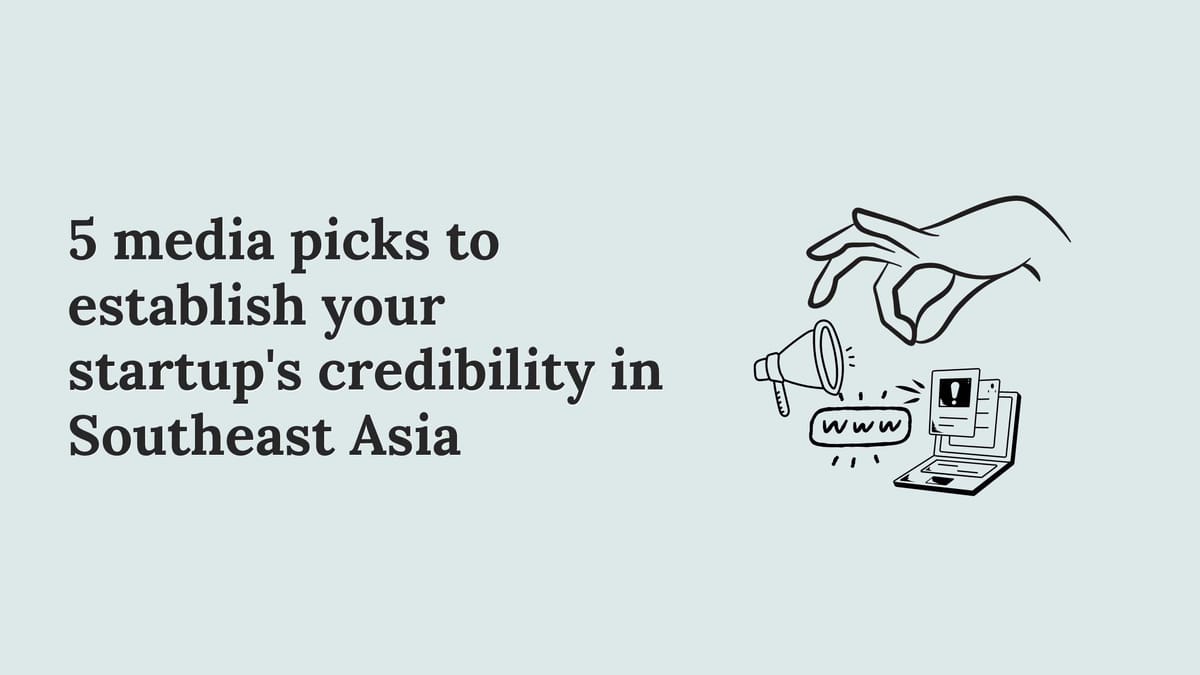How Southeast Asia's startup storytelling evolved beyond funding rounds
Manisha from e27 reveals why founders are shifting toward human-centered narratives and cross-border collaboration stories that actually resonate with readers

For more than a decade, e27 has been a household name in Southeast Asia’s tech startup scene, serving as a go-to source for news, insights, and community connections. While many media outlets cover the region, e27 stands out for its strong focus on amplifying voices through its Contributor Programme.
This platform allows founders, investors, and ecosystem leaders to share their stories directly with millions of readers. For startup founders, it is not just a publishing opportunity but also a way to shape conversations, build credibility, and connect with the wider community.
At the heart of this programme is Manisha Maity, who leads the initiative and works closely with contributors across the region. Under her guidance, the platform has played a key role in shaping how Southeast Asia’s fast-evolving startup landscape is told, shifting the focus from formulaic funding announcements to authentic narratives about building companies.
In this interview, she shares why certain topics consistently capture reader attention, which high-growth sectors still lack coverage, and how the rise of cross-border collaboration is changing the whole conversation.
Short on time?
Here is a table of content for quick access:
- Stories now reveal the "why" behind startup decisions
- AI, climate tech, and culture stories dominate reader interest
- Underreported sectors poised for breakthrough coverage
- Local context transforms global trends into compelling stories
- Cross-border collaboration signals ecosystem evolution
- The strategic imperative for authentic storytelling

Stories now reveal the "why" behind startup decisions
Southeast Asian startup storytelling has evolved significantly since Manisha Maity began leading e27’s contributor ecosystem.
“When I first joined e27, a lot of stories in the ecosystem focused on big funding rounds, product launches, or headline-grabbing milestones,” she explains. “Those are still important, but now there is a noticeable shift toward narratives that show the human side of building a company, such as lessons learned, personal challenges, and the values guiding decisions.”
Manisha sees this as a sign of a maturing ecosystem, where founders and contributors are more open to sharing authentic experiences.
“Founders and contributors are more willing to share the ‘why’ behind what they do, not just the ‘what,’” she notes.
This openness has created space for a wider range of voices, from early-stage founders sharing first-hand lessons to investors reflecting on broader market changes.
The shift toward authentic storytelling comes at a pivotal time. Southeast Asia’s digital economy generated US$100 billion in revenue in 2023, growing 1.7 times faster than the region’s gross merchandise value. The numbers suggest that businesses are moving away from a sole focus on growth toward building sustainable profitability. The way founders tell their stories reflects this maturity, with more emphasis on strategic thinking rather than just surface-level metrics.
The trend also mirrors broader content marketing research, which shows that stronger storytelling remains a top priority for marketers. Audiences increasingly seek personal connections through emotionally resonant and human-centered content.
In Manisha’s view, Southeast Asian founders are embracing this approach naturally, not because of outside pressure, but from a genuine desire to connect with their community.
AI, climate tech, and culture stories dominate reader interest
Recent content performance at e27 shows clear patterns in what resonates with Southeast Asia’s startup community.
“Topics around AI and its practical applications continue to draw a lot of attention,” Manisha reports. “There is also growing interest in climate tech and sustainability, especially when founders share tangible solutions or lessons from building in that space.”
The appetite for AI-related stories reflects wider regional investment trends. In 2024, Southeast Asia’s AI sector received more than US$30 billion in infrastructure investment, fueled by rising demand for automation, artificial intelligence, and big data in industries such as manufacturing, retail, and logistics.
Even so, Manisha notes that readers connect more strongly with content about real-world use cases rather than abstract or purely theoretical discussions.
Productivity, leadership, and company culture articles also perform well, particularly when grounded in personal experience.
“Our readers respond best to content that feels both timely and human,” she explains. “It is not just about spotting a market trend. It is about hearing how real people in the ecosystem are navigating it.”
This preference for human-centered storytelling reflects broader content marketing shifts in the region. More brands are focusing on ethical storytelling that highlights positive social impact, fair trade practices, and community engagement, while avoiding the exploitation of cultural elements.
Readers, Manisha suggests, have developed a sharper instinct for identifying content that is purely promotional.
The growing interest in climate tech also mirrors changes in the investment landscape. In 2024, sustainable and profitable startups have attracted greater investor attention, especially those with a clear path to long-term viability and responsible business practices.
This creates a reinforcing cycle where founder stories about climate-focused solutions engage readers and capture investor interest at the same time.
Underreported sectors poised for breakthrough coverage
Despite rapid growth in several sectors, Manisha sees clear gaps in coverage that could be rich territory for impactful storytelling.
“Agri-tech is one,” she notes. “The region’s agricultural backbone makes innovation in this space vital for food security and sustainable practices.”
Her observation is backed by recent investment trends, with agritech startups tackling challenges through IoT, SaaS, marketplace platforms, and credit solutions. Many early movers are now building on their initial success to aggregate supply and expand their market reach.
Ocean-related innovation is another area she believes deserves more attention.
“Given how many communities here rely on marine resources and are directly affected by climate change, these stories could shine a light on important environmental and economic intersections,” she explains.
The focus on ocean innovation fits naturally with Southeast Asia’s geography and its growing climate awareness.
Healthcare technology, particularly solutions that improve access in rural areas, is advancing quickly but often struggles to break into mainstream conversation. This lack of visibility is notable in a region with varied development levels and where the importance of healthcare access was made clear during recent global challenges.
The creative economy, from gaming to music tech, also receives only sporadic coverage, despite its significant cross-border potential.
“Its potential for both economic growth and cultural influence is still underexplored,” Manisha says.
With Southeast Asia’s young, digitally native population and its growing success in cultural exports, she sees untapped opportunities here.
For content creators and PR professionals, these gaps point to emerging narratives that could help define the region’s next phase of growth and position their stories at the center of it.
Local context transforms global trends into compelling stories
For contributors and marketers aiming to create content that truly connects with Southeast Asian audiences, Manisha stresses the importance of grounding stories in genuine local context.
“It is one thing to write about a global trend, but it becomes far more engaging when you show what it means for a founder in Jakarta, a startup in Manila, or an investor in Ho Chi Minh City,” she explains.
This kind of localization goes beyond simply mentioning a location. It requires an authentic understanding of local culture and business realities.
Her advice reflects a broader shift in content marketing toward hyper-localization, where brands incorporate cultural symbols, traditions, and values unique to each market. Many are investing time and resources into understanding these nuances so that their messages feel native and authentic.
For PR professionals, Manisha points out a long-standing challenge: finding the right balance between promotional goals and genuine value creation.
“Readers in this space can tell when something is purely promotional, and they respond much better to stories that teach, spark ideas, or share honest experiences from the field,” she explains.
This heightened reader awareness means content must meet higher standards and be guided by more thoughtful storytelling strategies.
She also encourages looking beyond the traditional success narrative.
“Not every story needs to be about big wins,” she says. “Stories about mistakes, pivots, or unexpected turns often carry lessons that are just as valuable, if not more, than a success story.”
This openness to sharing failures and lessons learned reflects a broader cultural shift in the startup world, where resilience and sustainable growth are valued more than relentless pursuit of scale.
For PR professionals, it opens the door to compelling narratives about strategic pivots, market insights, and adaptive leadership. Which are the kind of stories that might not have resonated in the ecosystem’s earlier stages but are now embraced as signs of maturity.
Cross-border collaboration signals ecosystem evolution
Looking ahead, Manisha is especially excited about the rise of cross-border collaboration among regional founders.
“I am seeing more conversations where startups are thinking beyond their home market right from the start,” she says. “That might mean tapping into neighboring talent pools, co-developing products, or partnering to enter new markets together.”
It is a notable shift from the more siloed approach that once defined early-stage startup growth in Southeast Asia.
“It feels like a move away from working in isolation toward building a more connected regional ecosystem, which can strengthen innovation in the long run,” Manisha explains.
The trend mirrors broader efforts to integrate the region’s economies. The ASEAN Digital Masterplan 2025, for example, outlines strategies to expand digital financial services and drive adoption of e-payments and digital banking across member states. This kind of infrastructure supports exactly the kind of collaboration she is seeing.
For content strategy, this evolution opens new doors. Stories that highlight successful cross-border partnerships, shared regional challenges, and collaborative approaches to overcoming market entry barriers are likely to resonate with audiences who are already thinking beyond national borders.
For content creators and PR professionals, it is a chance to build narratives around regional leadership, collaborative innovation, and shared market development. Themes that would have been far less relevant when startups were focused mainly on their domestic markets.
The strategic imperative for authentic storytelling
The changes Manisha describes at e27 mirror broader shifts in Southeast Asia’s startup ecosystem, bringing both new opportunities and higher expectations for sophisticated storytelling.
The region’s digital economy is projected to reach US$600 billion in gross merchandise value by 2030, with the potential to hit US$1 trillion under the right conditions. As this growth unfolds, competition for attention, investment, and talent will only increase.
Thriving in this environment will require content that reflects a deep understanding of local contexts, shares authentic founder experiences, and demonstrates strategic thinking about regional opportunities.
The rise of cross-border collaboration and the growing appetite for human-centered narratives are creating space for stories that might have felt premature in the ecosystem’s earlier stages but now offer a strong competitive advantage for companies ready to tell them well.




